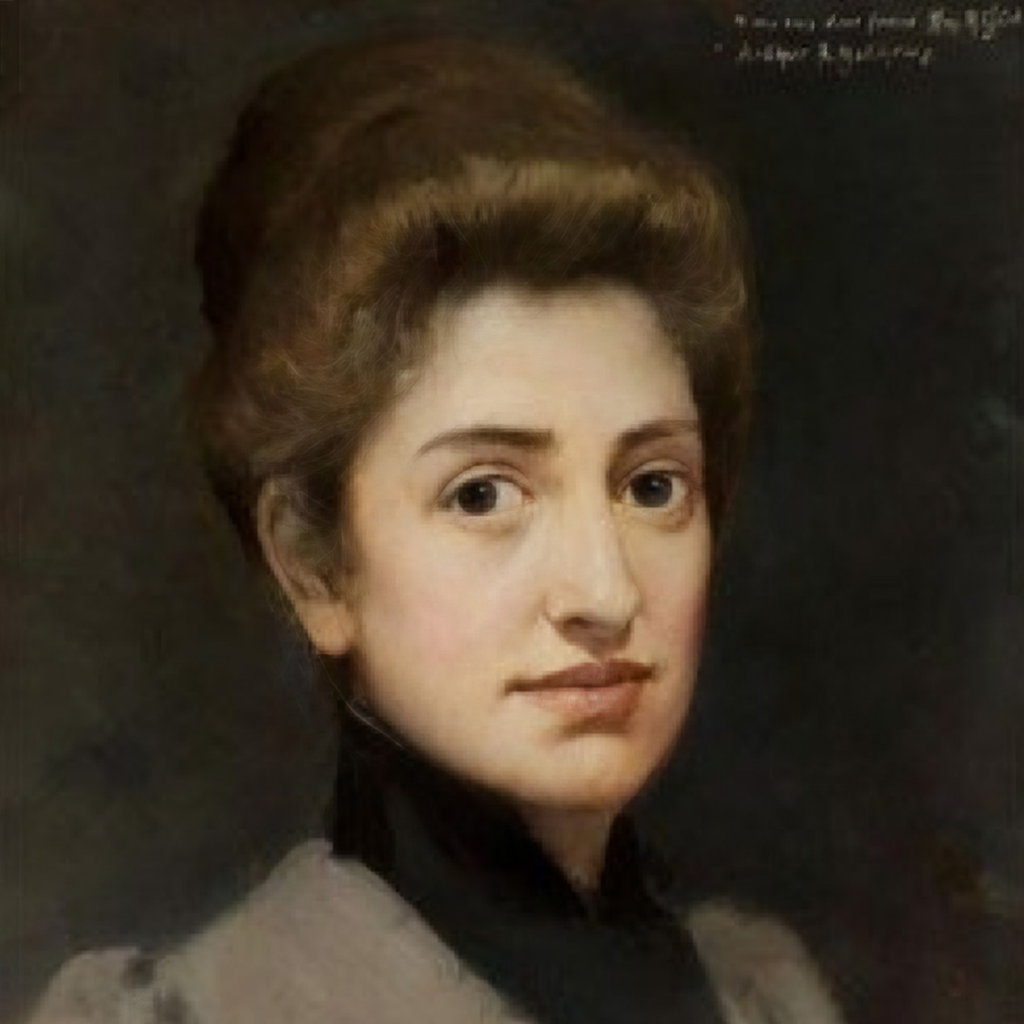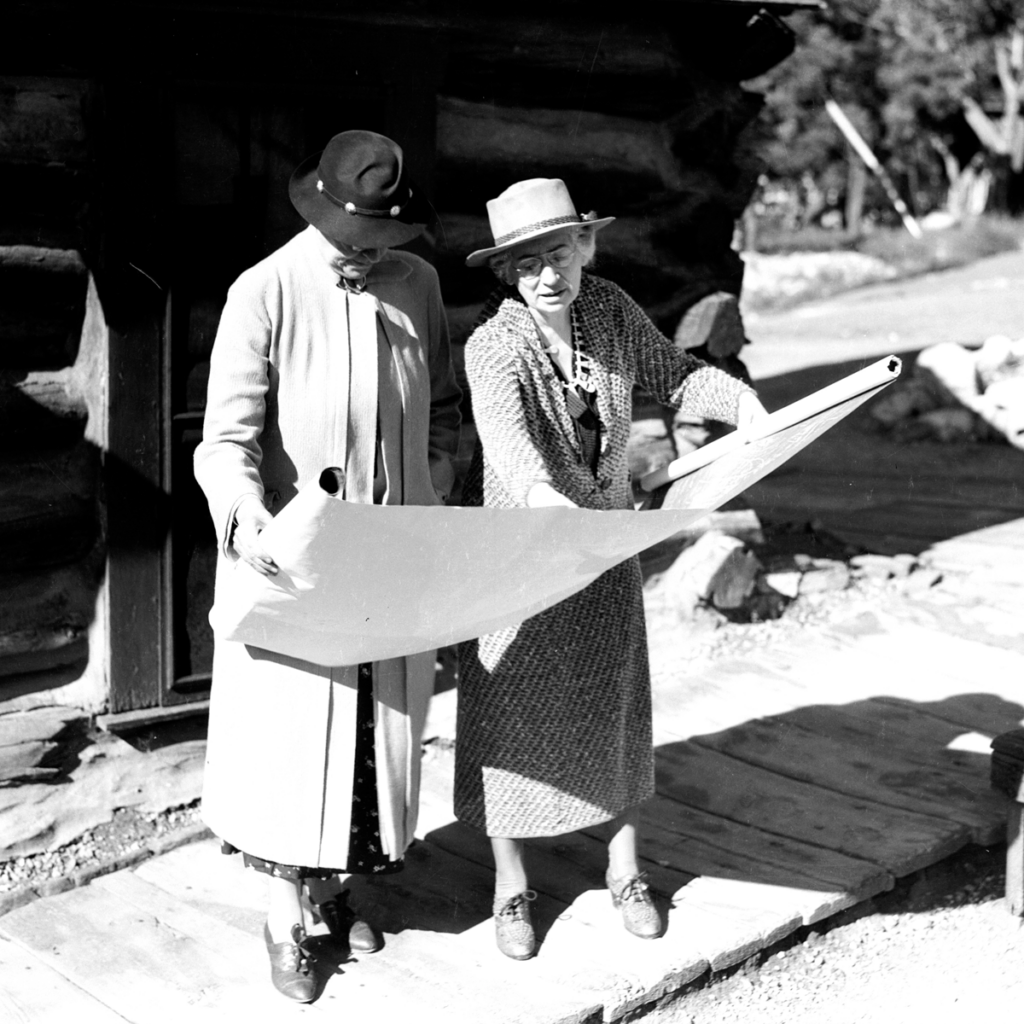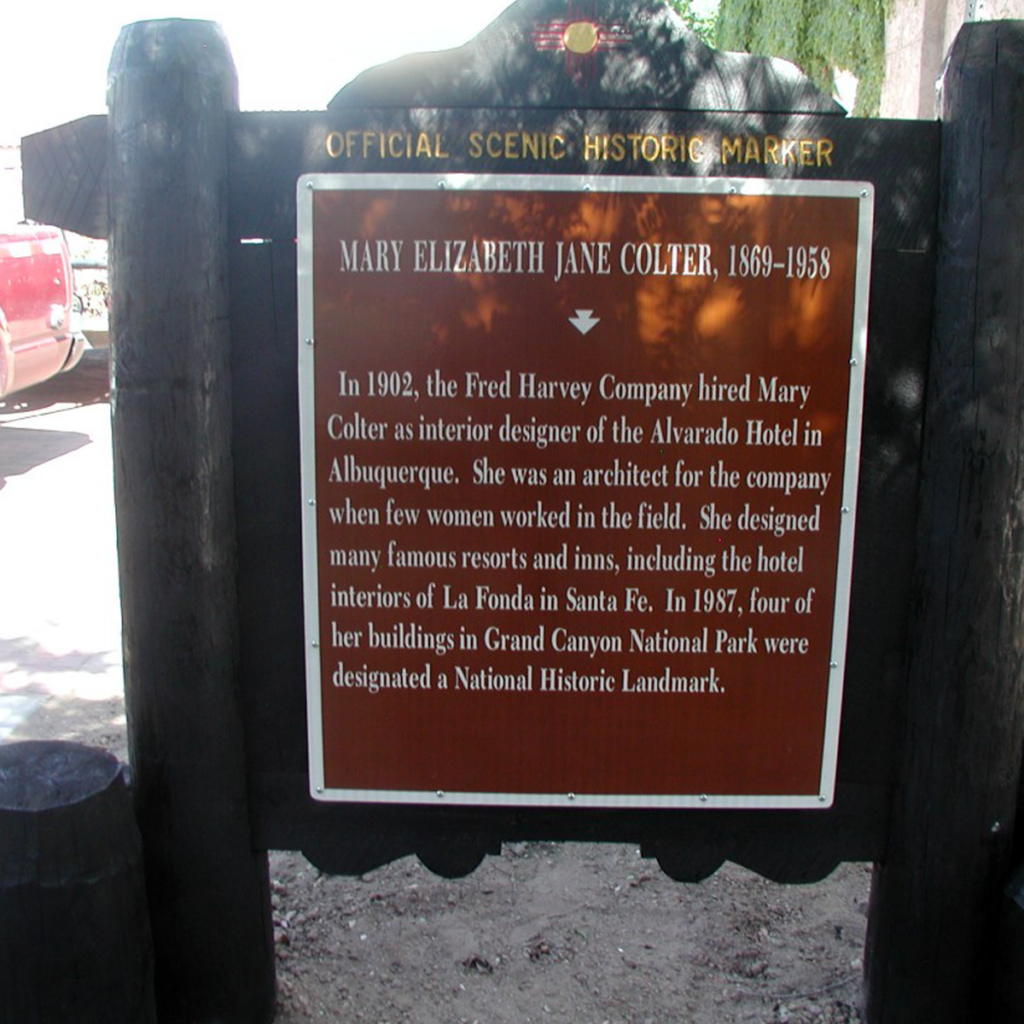Mary Elizabeth Jane Colter.
Photo Credit: Courtesy of New Mexico Historic Women Marker Program.
Mary Elizabeth Jane Colter
1869 - 1958
Bernalillo County
Artist
|
She designed some of the greatest hotels of the Harvey Hotel chain, including the Hopi House, Hermits Rest, Lookout Studio, Phantom Ranch, Desert’s View Watchtower, and the Bright Angel Lodge, all of which were added to the National Registry of Historic Buildings in 1987.
Mary Elizabeth Jane was truly a child of her times, someone uniquely suited in her talent and temperament to the burgeoning Arts and Crafts movement in the late 19th century. Her unique knowledge of native crafts and an innovative eye for merchandising and marketing made her the perfect designer for the Harvey Company, and her buildings and designs became the hallmark of the Harvey Company image. She was noted for coming up with what would become known as the National Park Service Rustic as she helped the Harvey Company develop the Grand Canyon National Park.
Born in Pittsburgh in 1869, she moved around the Midwest with her family before settling in Minnesota when she was 11, and always considered St. Paul her home. She had an artistic bent, but knew she needed higher education to pursue her dreams. Her father’s death in 1886 provided the necessary impetus. She convinced her mother to allow her to attend art school and the family moved to Oakland, California, so that Mary could attend school at the California Institute of Design in San Francisco. There she became part of the emerging arts and crafts movement. She also apprenticed at a local architectural firm.
After graduation, she returned to Minnesota with her mother and sister and began teaching at the Stout Manuel Training School in nearby Menomonie, Wisconsin, and later at the Mechanic Arts High School in St. Paul. Over time, she became well known in the community for her designs and talents and she became familiar with arts and crafts of native people as well.
She spent the next several years honing her skills within the arts and craft movement. In 1901, she received a telegram from the Fred Harvey Company summoning her to the Southwest for the summer of 1902 to design the interiors of the Indian Building at the Alvarado Hotel in Albuquerque. The commission was the start of a relationship that lasted the rest of her life and took her to places she’d never dreamed of. Her unique knowledge of native crafts and an innovative eye for merchandising and marketing made her the perfect designer for the Harvey Company. Her buildings and designs became the hallmark of the Harvey Company image.
After her first commission with the Fred Harvey Company, she returned to Minnesota and continued teaching but accepted another appointment with the Fred Harvey Company in the summer of 1904 to create the Hopi House at the Grand Canyon across from the famed El Tovar Hotel. She created a truly unique building that combined elements of native structures and natural materials from the area. It had space for Hopi families to live in as well as demonstration space and sales rooms.
She was asked to do additional projects for the company over the next few years and was finally hired as the chief architect for the entire Harvey Company in 1910. Because of the unique relationship between the company and the Santa Fe Railroad, the Santa Fe Railroad paid for part of her salary. Although she ostensibly lived in Kansas City, her true home was along the railroad and later the great highways of the West in the Harvey Hotels along the route.
Between 1910 and 1922, Colter designed some of the greatest hotels of the Harvey chain, including remarkable buildings at the Grand Canyon Village like Hermits Rest, the Lookout Studio, and the Watchtower. These buildings along with the Hopi House were added to the National Registry of Historic Buildings in 1987. Her hotels included El Navajo in Gallup, NM; El Ortiz in Lamy, NM; and La Posada in Winslow, Arizona.
Colter was not a registered architect. She was trained and apprenticed in California at a time before licensing was required. Her unique position with the Harvey Company and the Santa Fe Railroad allowed her to pursue architecture without concerns about licensing. The engineers and architects of the Santa Fe Railroad signed off on her designs and created the working drawings.
Throughout her life she collected native baskets, pottery, and jewelry, often directly from the artists themselves. She donated her collections to various institutions in the Southwest including Mesa Verde National Park Museum. Upon retirement, she moved to Santa Fe. She left retirement briefly to work on the interiors of La Fonda Hotel in Santa Fe.
Mary Colter was a true pioneer and a rare alpha female of the architectural world. Her dominance and influence on America’s tourist culture was unmatched for many years. She possessed a unique ability to interpret native materials and designs into buildings that were well-suited to their surroundings.
Over the years, as the railroad declined and air travel reduced long distance road travel, the Harvey Company declined as well and many of its resorts and hotels were torn down. Recently there has been a resurgence of interest in Colter’s designs and efforts are being made to preserve those that are left.
Sources:
Berke, Arnold. Mary Colter: Architect of the Southwest. New York: Princeton Architectural Press, 2002.
Grattan, Virginia L. Mary Colter: Builder Upon the Red Earth. Grand Canyon, AZ: Grand Canyon Natural History Association, 1992.
Morris, Juddi. The Harvey Girls: The Women Who Civilized the West. New York: Walker and Company, 1994.
Poling-Kemps, Leslie. The Harvey Girls: Women Who Opened the West. New York: Marlowe and Company, 1991.
Directions:
Mary Elizabeth Jane Colter
Bernalillo County
Artist |
Statehood (1912 - present) | Territorial Period (1848 - 1912) |
Central









